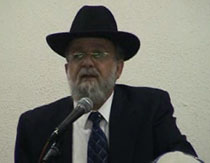Beit Midrash
- Sections
- Chemdat Yamim
- P'ninat Mishpat
Ruling: [Last time we dealt with basic principles and the possible complications of the insurance company’s refusal to accept beit din’s ruling.]
Poskim posit that traffic laws are relevant in determining culpability. This can be either based on societal acceptance (Chishukei Chemed, Bava Kama 31a), the law of the land (Techumin XIX, pp. 258-270; our ruling 71004), or just helping to determine who went against the norm (Pitchei Choshen, Nezikin 1:(71)).
According to pictures taken after the accident, pl’s car had turned around 45 degrees and about a quarter of the car was still within the perpendicular parking area. Def’s car was in its lane. This, along with the place of collision being corner to corner, support def’s claim that pl unsafely entered the street’s driving lane. On the other hand, it is also possible that, as pl claimed, that he started to make a three-point turn, giving def, whom he saw, enough time to stop, but def did not notice him. Rule 44 of the traffic laws states that one may not turn around and thereby enter the opposite lane if it causes a disruption of the traffic or a danger. Rule 64 is even clearer regarding care that must be taken when pulling out of a parking space. This implies that the obligation to be careful is more incumbent on the one entering a new lane. Therefore, in this case we can determine that pl acted "without permission."
According to pl, def also acted without permission, as he was looking elsewhere and not on the road. However, pl has no proof, and there is no clear reason to think def was looking elsewhere (it was his own street). It is not clear that pl was even able to see def’s face. Def would have to take a Rabbinic oath that he was concentrating on the road, in lieu of which, batei din make compromises, in which their evaluation of the situation plays a role. Members of the beit din reasoned that there is no need for a compromise in this case. For one, pl definitely acted improperly, and we do not know about def, and there is an assumption that people drive responsibly. Also, according to the Shulchan Aruch (see last week), def has the advantage in that all agree that pl saw def and def did not see him. Therefore, def is exempt from paying for damages to pl’s car. For the same reasons, def is exempt from any raising of pl’s premium.

P'ninat Mishpat (801)
Beit Din Eretz Hemda - Gazit
682 - Car Accident – part II
683 - Was There a Sale to Renege on? – part III
684 - Payments after a Gradual End of Employment
Load More

P'ninat Mishpat: Smoking Rights in a Rental? – part I
based on ruling 85076 of the Eretz Hemdah-Gazit Rabbinical Courts
Beit Din Eretz Hemda - Gazit | Tishrei 5786

P'ninat Mishpat: A Seller with Questionable Rights to the Property – part I
based on ruling 84062 of the Eretz Hemdah-Gazit Rabbinical Courts
Beit Din Eretz Hemda - Gazit | Cheshvan 5786

P'ninat Mishpat: Amounts and Conditions of Payment to an Architect – part III
based on ruling 83061 of the Eretz Hemdah-Gazit Rabbinical Courts
Beit Din Eretz Hemda - Gazit | Sivan 5785

P'ninat Mishpat: End of Tenure of Development Company – part II
based on ruling 77097 of the Eretz Hemdah-Gazit Rabbinical Courts
Beit Din Eretz Hemda - Gazit | Tammuz 5785

Beit Din Eretz Hemda - Gazit

A Commercial Rental for a Closed Business – part II
based on ruling 80047 of the Eretz Hemdah-Gazit Rabbinical Courts
Shvat 1 5782

Interceding Regarding a Will
Igrot Hare’aya – Letters of Rav Kook #105
Sivan 28 5782

Raffle of Property in Eretz Yisrael for Tzedaka
Igrot Hare’aya – Letters of Rav Kook: – #220
18 Sivan 5784





















